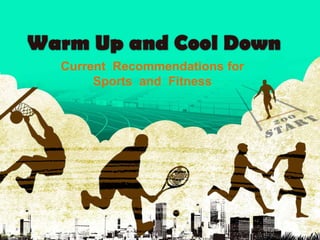
Sports 02
- 1. Warm Up and Cool Down Current Recommendations for Sports and Fitness
- 2. Static Stretching For years, students and coaches were taught that to prevent injury, we should warm up and then stretch. Most understood that stretching meant STATIC stretching or stretches where you held a stretched position for 20 30 seconds. Within the last 8 years, many studies have examined this method and have found that STATIC stretching done in conjunction with the warm up may actually decreaseperformance and increase the risk of injury. A Google search will easily bring you to numerous articles explaining the science behind this. In Health & Phys Ed classes, our students are taught these current training recommendations. Our desire, along with the High School Strength & Conditioning Department, is to have our student athletes following these recommendations in their extracurricular sports. Dynamic Stretching
- 3. Warm Up A well-designed warm-up starts by increasing body heat and blood flow. Warm muscles and dilated blood vessels pull oxygen from the bloodstream more efficiently and use stored muscle fuel more effectively. They also withstand loads better. This general warm up should be anywhere from 5-10 minutes in length and performed at low to moderate intensities. Walking, jogging, & jumping rope are good examples.
- 4. Warm Up - Dynamic After performing a general warm up, one should then include a more specific warm up that uses activities that are similar to the sport or fitness activity. These should be done for 5-10 minutes and progress from moderate to higher intensities depending on the activity. The general idea is to think about what actions are involved and then perform these in a controlled setting to warm up more thoroughly the muscles/joints/tendons and to also warm up the nervous system. Some examples include: Jogging, skipping (forward and backward), walking lunges, carioca, arm circles, bear crawl, high knees, butt kicks, Frankenstein walk, & leg swings. These are just a few that you might use. Again, one can find a lot on the internet concerning this but we would recommend asking our phys ed staff which has strength and conditioning experience at both the high school and collegiate level or Brian Coleman (bcoleman@uaschools.org) who is the UA High School Strength and Conditioning Coordinator.
- 5. Dynamic Warm Up Examples Carioca Skipping High Knees Butt Kicks Backpedaling Frankenstein walk Arm Circles Walking Lunge Bear Crawl
- 6. Cool Down Static stretching is still a great way to increase or improve one’s flexibility and the cool down is the perfect place to use this flexibility method. Muscles are warm and ready to stretch and the act of stretching is great for helping continue the cool down process and for removing metabolic waste products. Make sure your athletes have reduced their heart rates below 125bpm by using a low intensity activity like walking. Follow a static stretching program that targets the major muscle groups, especially those used during your practice or activity. Hold stretches for at least 20 seconds but no longer than 60 seconds. Repeat stretches for areas where athletes have trouble. Again, if you need assistance with a static stretching program, the Phys Ed department will gladly help.
- 7. This is a video of Coach Coleman taking the UA High School Basketball team through a dynamic stretching routine.
- 8. Here we have included a link to a recent article in the NY Times concerning dynamic and static stretching. http://www.nytimes.com/2008/11/02/sports/playmagazine/112pewarm.html This is a link to a video that was posted with the above article that we felt was very informative. http://video.nytimes.com/video/2008/10/31/sports/playmagazine/1194830066044/stretching-the-truth.html
- 9. Thanks! We look forward to working with you.